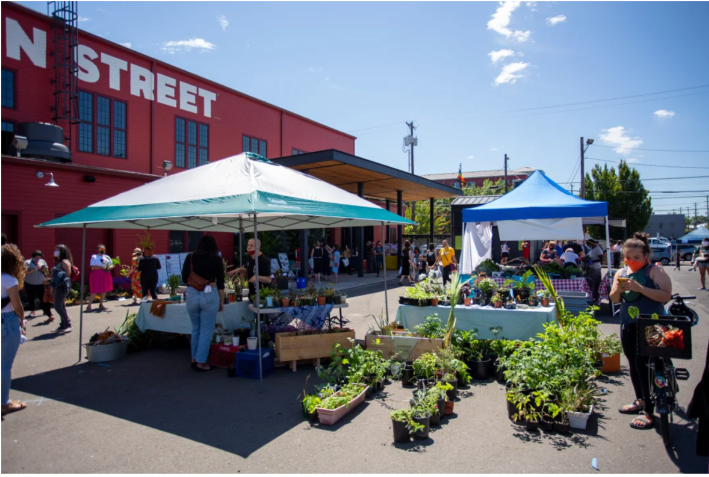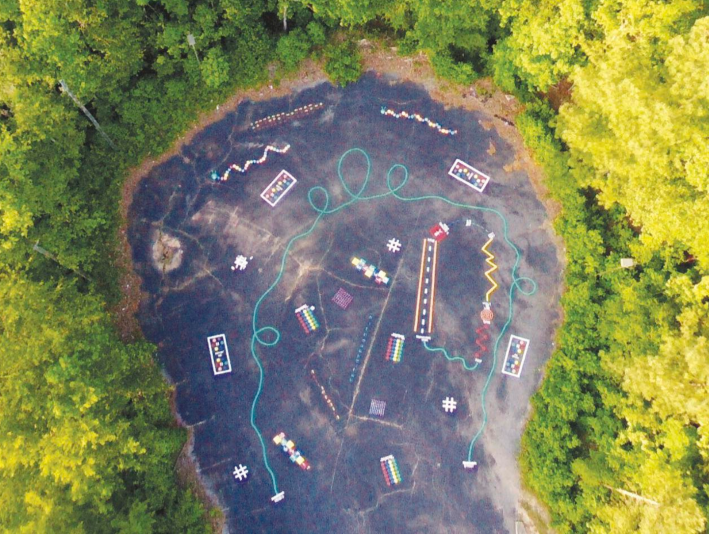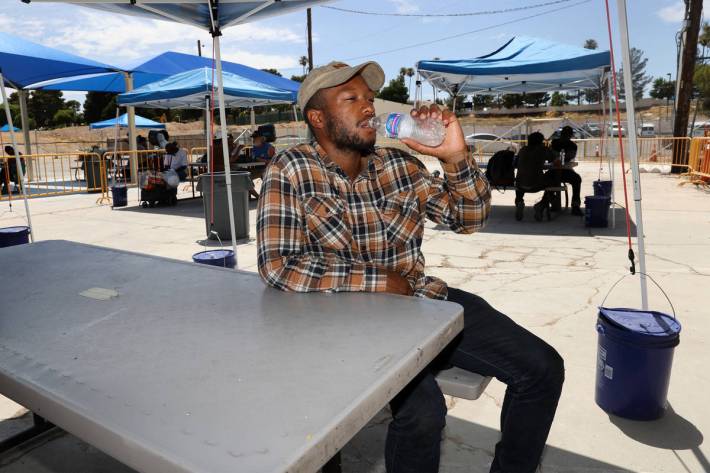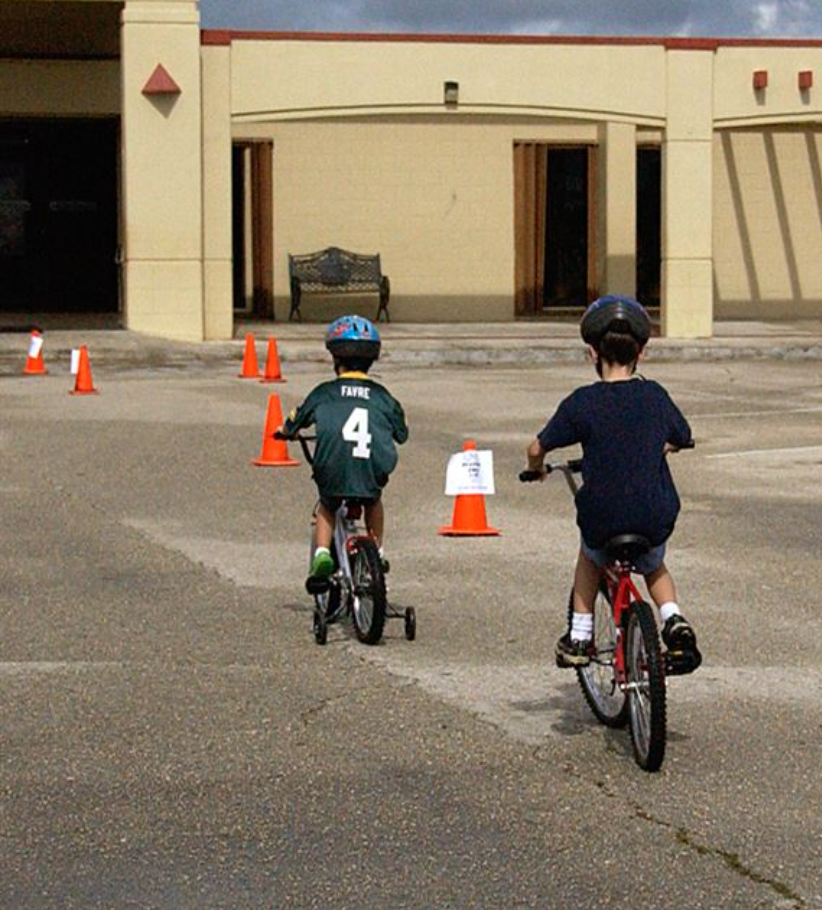If there's one thing America definitely doesn't need any more of, it's parking lots — and during COVID-19, communities across the U.S. are seizing that under-utilized asphalt for pandemic-safe and equitable ways.
As many urbanists debate the implications of re-allocating curb and lane space from drivers to other road users without a robust public process, there's been virtually no conversation about the other vast swaths of asphalt our cities routinely dedicate to strong private cars: off-street lots, which comprise a sizable chunk of the roughly two billion parking spots the U.S. maintains for the storage just 250 million cars.
That's a bizarre omission, as many private and publicly owned parking lots have stood even more empty than usual since March — and have stayed that way even as traffic volumes have begun to rebound up to 90 percent of pre-pandemic levels. Many of the mega-businesses that routinely create horrific parking craters in our communities — think shopping malls, sports stadiums, and large entertainment venues — still largely remain closed or on tightly restricted capacity limits today, even as smaller businesses have eased up on quarantine measures.
And countless smaller lots astride neighborhood institutions — such as paved school yards during summer break, empty asphalt outside worship spaces, underutilized lots astride transit stops — are famous for sitting empty most of the time, never mind during a pandemic when there simply is no such thing as education, worship or transit as we previously knew it.
Here are just five examples of how parking lots can be activated for better purposes.
1. COVID-safe farmer's markets
With some simple spacing and capacity restrictions, the outdoor market may be the safest way to get groceries during COVID-19 — and done right, it can even be a crucial source of support for Black- and Latinx-owned businesses whose food has historically been underrepresented in the diet of the average locavore.
Portland's new Come Thru market is using parking lots to safely spread out customers and connect BIPOC farmers and vendors with predominantly BIPOC consumers in their neighborhoods. Organizer Allinee “Shiny” Flanary told PDX Monthly that the most recent event attracted "the most Black folks at a farmers market that you have ever had at Portland.” And it likely kept them safer than more familiar farmer's park-based markets that tend to be crowded — and because they are often located in a predominantly White neighborhoods, can be less accessible to BIPOC residents.

2. No-contact play zones
Kids need physical activity even when they're in quarantine — and just because crowded, high-touch playgrounds are a no-go doesn't mean we have to keep the fun indoors.
When their district shifted to remote learning, teachers and staff at Battleground Elementary in Lincolntown, N.C. painted an interactive, no-contact play course on the school's vacant parking lot. Simple paint on the ground guides students through a range of socially distant games, including a “follow me” track, giant Tic-Tac-Toe, “Dot and Boxes,” hopscotch, and an obstacle course — all of which help students who struggle to get the physical activity and play time they need when school isn't in session. That may be a particularly important resource for a school that serves predominantly low-income, non-White students who are less likely to have access to private place spaces like personal backyards: 96 percent of students at Battleground are eligible for free or reduced lunch programs, and the school ranks in the top 20 percent for racial diversity statewide.

Friend of Streetsblog Sam Balto, a physical education teacher in a predominantly non-White school district in Portland, Ore., had a similarly brilliant idea to help his students by activating a vacant school lot. He built a no-contact "traffic garden" in a vacant school parking lot to give families a car-free space to practice street safety skills during the summer — and the idea was so popular, he's now built four gardens and counting across the region.
This summer join me in the #TrafficGardenProject!! It’s time to find some underutilized asphalt & transform it for children. pic.twitter.com/7pDt2eoL9U
— Sam Balto (@CoachBalto) June 29, 2020
3. Parking lot protests
Protest has always been a crucial element of American street life, but it has perhaps never been so common as in the wake of the killing of George Floyd by Minneapolis police. And some communities aren't just taking to the streets — they're creating protest spaces in parking lots, too.
Some of the most famous parking lot demonstrations have occupied symbolically significant location, the lots outside of police stations that house officers that have brutalized Black protesters, big box stores that exploit Black labor, and the now-infamous Wendy's lot in Atlanta where police officers killed Rayshard Brooks.
Other Black communities have used the parking lots outside their worship spaces to create COVID-safe and family-centered outdoor spaces for protest, prayer, and anti-racist community organizing, like the Spring of Hope Church of God in Christ in Springfield, Mass.
4. Public health outreach
Chances are by now, most Streetsblog readers have seen a parking lot or two repurposed for drive-through COVID-19 testing — and chances are, most of you have grumbled about how challenging it can be to access safe, outdoor testing without a car. But some grassroots organizers are using lots for more informal, walk-up public health services, like these Memphis activists who hosted pop-ups to hand out personal protective equipment, hand sanitizer, voter registration resources, information on seeking help for those experiencing intimate partner violence, and more mutual aid services residents might need.
PPE for BIPOC is on the ground in Memphis handing out free kits with masks, hand sanitizer and more for the homeless and those in need. Details on #GoodDayMemphis pic.twitter.com/ZF4C38nTX7
— Jalyn Souchek (@JalynSouchek) July 10, 2020
5. Shelter for the unhoused — or just a place to sit and cool down
Not all unhoused people want to live in city-run shelter environments, at least as they exist now — and that's even more true during the COVID-19 pandemic, when shelters pose terrifying new risks. At the same time, finding more isolated indoor shelters like hotels has proved challenging for a raft of financial, practical and political reasons — not least the fact that some unhoused people themselves prefer to live in outdoor tent encampments, where they are not subject to city-mandated family separation, curfews, bans on controlled substances that can be lethal for chemically dependent addicts, and other onerous restrictions imposed by the city or the hotel partner.
Las Vegas first sought to meet the needs of such unhoused people with a decidedly bad parking lot project, where unhoused people were corralled into unsheltered parking spaces outfitted with thin blue mats for sleeping bags. But the city's policy has evolved since then, including the erection of a tented structure on the same lot, along with tented "cooling centers" where residents who prefer not to sleep in a city-run shelter can at least take some refuge from the heat during the day, eat a meal, and access a range of medical and support services in one centralized place.

The examples above give just a taste of the many, many ways that communities are using vacant parking lots during the pandemic — and there are countless more good strategies we're not trying yet, at least not at scale.
As the "al fresco" dining movement claims on-street parking spaces in major cities across America — sometimes without involvement of the surrounding neighborhood, and sometimes even at the expense of space for active transportation — relatively few suburban-style restaurants seem to be setting up tables in their parking lots, much less collaborating with cities to make their newly-outdoor eateries more accessible to diners without cars. And then there are the parking lot projects that communities are organizing against: Denver residents, for instance, are currently fighting a proposal to convert the unused parking lot of a local events arena into a safe outdoor space for the local unhoused to avoid crowded and unsafe shelter conditions.
One thing's for sure: by deliberately centering the needs of our most underserved citizens, parking lot repurposing can become a powerful tool for advancing equity and aiding public health efforts in the public realm.
And in one case from New York's low-income Inwood neighborhood, sometimes taking space from cars is just good fun.






